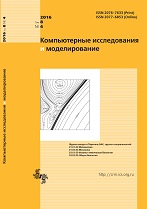|
This article is cited in 2 scientific papers (total in 2 papers)
ANALYSIS AND MODELING OF COMPLEX LIVING SYSTEMS
Investigation of the relationships of the size and production characteristics of phytoand zooplankton in the Vistula and Curonian lagoons of the Baltic sea. Part 1. The statistical analysis of long-term observation data and development of the structure for the mathematical model of the plankton food chain
K. A. Podgornyia, O. A. Dmitrievaa, A. S. Semenovaa, A. V. Leonovb
a Atlantic Research Institute of Marine Fisheries and Oceanography (AtlantNIRO),
5 Dm. Donskoy st., Kaliningrad, 106022, Russia
b Shirshov Institute of Oceanology, Russian Academy of Sciences,
36 Nakhimovskii prospect, Moscow, 117851, Russia
Abstract:
In the paper the statistical relationships between the size and production characteristics of phytoplankton and zooplankton of the Vistula and Curonian lagoons, the Baltic Sea, were investigated. Research phytoplankton and zooplankton within the Russian part of the area of the Vistula and the Curonian lagoon was carried out on the monthly basis (from April to November) within the framework of long-term monitoring program on evaluating of ecological status of the lagoons. The size structure of plankton is the basis for understanding of the development of production processes, mechanisms of formation of the plankton species diversity and functioning of the lagoon ecosystems. As results of the work it was found that the maximum rate of photosynthesis and the integral value of the primary production with a change in cell volume of phytoplankton are changed according to a power law. The result shows that the smaller the size of algal cells in phytoplankton communities the more actively occur metabolism and the more effective they assimilate the solar energy. It is shown that the formation of plankton species diversity in ecosystems of lagoons is closely linked with the size structure of plankton communities and with features of development of the production processes. It is proposed the structure of a spatially homogenous mathematical model of the plankton food chain for the lagoon ecosystems taking into account the size spectrum and the characteristics of phytoplankton and zooplankton. The model parameters are the size-dependent indicators allometrically linked with average volumes of cells and organisms in different ranges of their sizes. In the model the algorithm for changes over time the coefficients of food preferences in the diet of zooplankton was proposed. Developed the size-dependent mathematical model of aquatic ecosystems allows to consider the impact of turbulent exchange on the size structure and temporal dynamics of the plankton food chain of the Vistula and Curonian lagoons. The model can be used to study the different regimes of dynamic behavior of plankton systems depending on the changes in the values of its parameters and external influences, as well as to quantify the redistribution of matter flows in ecosystems of the lagoons.
Keywords:
ecosystem, nutrients, phytoplankton, zooplankton, plankton detritus, size structure, the maximum rate of photosynthesis, integrated primary production, zooplankton production, allometric scaling, Shannon index of species diversity, mathematical modeling, ecological simulation model, turbulent exchange.
Received: 15.10.2016
Revised: 17.01.2017
Accepted: 01.03.2017
Citation:
K. A. Podgornyi, O. A. Dmitrieva, A. S. Semenova, A. V. Leonov, “Investigation of the relationships of the size and production characteristics of phytoand zooplankton in the Vistula and Curonian lagoons of the Baltic sea. Part 1. The statistical analysis of long-term observation data and development of the structure for the mathematical model of the plankton food chain”, Computer Research and Modeling, 9:2 (2017), 211–246
Linking options:
https://www.mathnet.ru/eng/crm59 https://www.mathnet.ru/eng/crm/v9/i2/p211
|

| Statistics & downloads: |
| Abstract page: | 303 | | Full-text PDF : | 209 | | References: | 50 |
|




 Contact us:
Contact us: Terms of Use
Terms of Use
 Registration to the website
Registration to the website Logotypes
Logotypes









 Citation in format
Citation in format 
